“A Cultural Anthropological Study of Body Techniques for Protection: The Case Study of Indonesian Minangkabau
Seiji MURAO*
*The Centre for the Promotion of Integrated Sciences (Visual Anthropology), The Graduate University for Advanced Studies, Kanagawa, Japan
Introduction
Throughout the Malay cultural sphere, there is a widespread art of self-defense based on physical techniques. The names of these differ by region and do not exhibit uniformity in movement, technique, aim, and social significance. This paper examines the techniques passed down under the name of silek as practiced widely among the Minangkabau people in the western part of Sumatra. It is said that one of the most original techniques were created in this area and have enjoyed its surpassing affluence among other regions in terms of regionally widespread extent and thickness of underlying social and generational layers of practitioners and their potential followers or successors[2].
Sumatra, located on the westernmost extremity of Indonesia, is the second biggest island in Indonesia and the sixth biggest in the world. Its Western side largely corresponds with the cultural sphere of the Minangkabau people. Geographically speaking, it comprises of an inland region called Darek and two coastal regions that lie on the Indian Ocean called Rantau and Pasisir. The inland region is the birthplace of the Minangkabau culture, and still forms the core region in which traditional culture is passed down. The region consists of three areas: Agam, Limapuluh Kota and Tanah Datar. The latter is the location for the fieldwork of this study. At the administrative level, West Sumatra consists of Padang (the provincial capital), Padang Panjang (the special district), and kabupaten (8 regencies).
The native language of Minangkabau is Minangkabau, a language of Malay origin. It is often said that the Minangkabau people have a particularly strong ethnic awareness among Indonesia's various ethnic groups. In addition, they are also known for their strong belief in Islam, even within Indonesia, a multi-ethnic country with the largest number of adherents of Islam in the world. Also, their society is founded on the basis of adat (customary laws), a matrilineal systems that on the surface would appear to be antithetical to the teachings of Islam. Their society's population size, if an ethnic group who continues to reside its homeland within a nation is taken as a unit, is said to be one of the largest in the world. (Umar, 1980:291-313).
In this paper, the technique called silek is not considered in its narrow sense; rather, I seek to investigate what kind of relationships it has built with adat, a religious practice in this region, by understanding the practices and traditions of silek as a physical technique that has widely infiltrated Minangkabau society. With this intention in mind, I carried out surveys mainly in the places of worship of the Minangkabau people known as surau. The daily religious practice of the Minangkabau people is principally carried out at two different sites. One is the masjid (mosque), the place of worship of adherents of Islam; the other is the surau, which are run by matrilineal clans. At surau, the teachings of Islam are practiced in a way that includes mystical aspects, and it is here that the practice of silek is performed. In addition, surau has been functioning as an indispensable locus where gathered people can talk over on everyday basis of the various problems that are generated when teachings of the matrilineal adat and of Islam come into contact with societal change towards modernizing, and through this everyday interaction they can arrange to adopt new measures to adjust to and get over unfolding discrepancies between traditional and modernizing ways of life[3].
Thus, we see that surau function as special places that unite the faith of individuals with society, and body techniques with the teachings of Islam, based on religious practices.
1. Background
As with other areas of Indonesia, the social and cultural conditions of West Sumatra, home to the Minangkabau people, are in a process of dynamic changes. What became clear from repeated interviews with local people is that many people feel that the Minangkabau society began to undergo major changes between the 1960s and 1970s. The cause of these changes, they explain, was the onset of a marked decrease in the number of surau from this period onward.
Policies for regional autonomy (otonomi daerah) were implemented in 1999 in multi-ethnic Indonesia, with each ethnic group becoming able to reflect their own ethnic characteristics in local government culturally and politically. The West Sumatra government came up with the cultural policy characterized by the slogan, “Return to nagari. Return to surau” (kembaki ke nagari, kembaki ke surau). nagari is the name of the traditional system of land division constructed by the Minangkabau people over a long period of history, and was an especially important part of their adat. However, the Suharto administration, which governed Indonesia for many years, reorganized and managed the country on a uniform basis from 1979 through a new system of dividing land called desa. In 1983, nagari was abolished in the Minangkabau society, leading to a dilution of the characteristics of their ethnic culture in local governance and to a weakening of the power of the adat. “Return to nagari” is an initiative to restore the Minangkabau people's traditional system of land division and to realize local autonomy based on their adat.
Meanwhile, surau has become important site of Minangkabau people's social life-which is based on nagari-as places for handing down adat, such as religious practice and the practice of silek, to the next generation. It was common for a single matrilineal clan (suku) to run a single surau; in addition, renowned imams attracted people from other nagari. While there were people of all ages at surau, from children to the elderly, the majority were young men who stayed there together while learning adat, Islam, knowledge of daily life, worldly wisdom, and silek. In this way, young men obtain their masculinity, by engaging in these activities and experiencing the rite of passage.
There is a reason why young Minangkabau-especially adolescent boys-have this custom of engaging in communal life at the surau. Minangkabau society has inherited a matrilineal system through adat, with all property such as houses and agricultural land inherited through girls. Thus, from adolescence, Minangkabau boys are expected to learn to become independent and to strive to learn the aforementioned kinds of knowledge during their stay at the surau. Then, when the time is right-sometime between their late teens and early twenties-they go to work away from home to pursue knowledge, experience and wealth. However, with the decrease in the number of surau, the number of young men who lead this traditional kind of life has also decreased.
“Return to surau” expresses a resolve to restore culture passed down at surau and traditional life based on nagari that is organized around surau, while focusing once more on surau whose number decreased due to the transformation from large families with a matrilineal clan to nuclear families. surau A, the location where I carried out participant observation, is a rare surau that has remained relatively active by attracting people even after the 1970s when the number of surau began to decrease in the Minangkabau society. surau A can be characterized by the eagerness of the imam and his strong willingness to pass on the practice of esoteric Islam (Sufism) and the tradition of silek kumango to the next generation.
2. Body Techniques of the Minangkabau People
It is said that each nagari passed down its own unique silek in the Minangkabau society until the 1950s. Many schools of silek still exist today, but the exact number is unknown. Some widely-known schools in West Sumatra include kumango, lintau, tuo, sitaralak, harimau, pauh, gunung merapi, and sungai patai. Although there are some exceptions, it is said that in many cases schools were named, for the sake of convenience, after the land where they were located by people living in other areas. In addition, there are many that have been passed down steadily between matrilineal clan and nagari without being given a particular name. In such cases, only those involved knew about the practice; it was not easy for an outsider, like myself to find out details.
The aims of many silek seen in the inland region of West Sumatra, where I carried out fieldwork for this study, are not sport competitions or performances in public settings. While we see pencak (a dance based on silat) and silat (martial arts/self-defense) distributed throughout each region of Indonesia, they have been integrated under the name of pencak silat and systematized as body culture representative of Indonesia. At the same time, Ikatan Pencak Silat Indonesia was established in the capital Jakarta in 1948 with the aim of promoting competitions that integrate sports and dance, both at home and abroad. At present, this association is under the jurisdiction of Indonesia's Ministry of Sports, and has a major presence throughout Indonesia's islands, such as Java. However, most of the silek in the inland region of West Sumatra are not members of this association. They have decided to maintain their distance from the large organizations and engage freely in their practices based on the adat of the Minangkabau society. As a consequence of this institutional context, while West Sumatra is said to have one of the richest traditions of body techniques in Indonesia, it is difficult to know the reality of silek in the inland regions.
2-1 - Historical Perspectives
Much of Minangkabau culture has been passed down orally, and there are few documents about silek. Their origins are therefore subject to various theories. Martial artist Draeger, who investigated the martial arts of various regions in Indonesia, holds the opinion that the origins of silek lie in Indian martial arts transmitted to Sumatra, a stopping point between India and China, sometime in the 8th century, a time when the Srivijaya Kingdom was flourishing (Draeger 1972).
In addition, the Minangkabau society has historical records called Tambo that weave together creation myths, oral traditions and historical facts. While originally handed down orally, with the Islamization of the Minangkabau society in the 16th century, the Tambo was written down in Arabic. These records give the following description of silek: in the 12th century when Pahariyangan -located to the south east of Mount Merapi, a towering mountain in the inland region of West Sumatra-was at the height of its prosperity, there was an advisor to Sultan Sri Maharaja Diraja (1101-1149) called Ninik Datuk Suri Diraja (1097-1198). This advisor had a deep knowledge of Minangkabau culture and, while collecting the adat and the traditions of the Minangkabau people, created the foundations for silek as a technique for fighting and self-defense as well as silek as dance, involving performances accompanied by metal percussion instruments such as talempongs and gongs. Since this time, silek extended throughout three regions, collectively known as Luhak Nan Tigo -Luhak Agam, Luihak Tanah Datar and Luhak Lima Puluh where the traditions of the Minangkabau people were handed down on a large scale in the inland region of West Sumatra. Furthermore, it also spread outside of Sumatra through the custom of young men moving away from home to seek work in distant places (Jamal 1985).
While handed down orally in this way, it is generally explained that the silek of the Minangkabau people was created by one single person who existed anywhere from three generations to more than a dozen generations ago, and that their techniques have been passed down generation after generation from masters to pupils. Also, in many cases, this person is either a datuk, the head of a matrilineal clan, or a renowned Islamic imam. In addition, it is often said that they started learning silek after encountering unusual things and events that could not be explained rationally, such as phenomena supposedly deriving from supernatural powers and magic.
For example, it was Syekh Abdurrahman Alkhalidy (1812-1932), known by the popular name of Syekh Kumango, who created the silek kumango school, one of the most well-known silek among the Minangkabau people and one in which I had the fortune of participating. Syekh Kumango (Syekh is the name given to a renowned Islamic imam), who was born and raised in a nagari called Kumango in the Tanah Datar region, devoted himself to the training of silek from an early age, but it was at surau B in 1862, that is after he had completed his pilgrimage to Mecca, when he began his practice exclusively for himself. At this surau, the teachings of Islam were practiced in a way that included esoteric elements, with adherents engaging in the practice of silek. It is also said that not only young people from the same nagari sought the teachings of this master but also many practitioners from throughout the Tanah Datar region.
The silek kumango school has been also passed down at surau A, one of the fieldwork locations in this study, through the father of surau A's imam who was a direct pupil of Syekh Kumango. At present, at surau B, the fact that the masters are now in their old age and changes in the values of the children towards silek means that silek is becoming something of the past here. In contrast, it is surau A that is passing down the richest forms of Sufism, herbalism and knowledge of silek taught by Syekh Kumango.
2-2 - The Practice of silek
The age of starting participation in silek differs by school. At this surau, which considers silek in its relationship with religious practice, one condition of joining is that practitioners be able to worship five times a day. Many start to practice silek between the ages of 10 and 15 after having undergone their circumcision.
Places where practices are carried out are called sasaran, which is usually a land that has been cleared in front of the surau, or a worship room within the surau. Practice begins from between 20:00-21:00 following the evening meal and evening worship (Maghreb), but does not always begin at the appointed time. In cases where they are conducted outside, practices that are carried out under moonlight or the light of a small lamp serve to heighten the vision and intuition of practitioners. Practices that are carried out in the pitch black of nature and in an unclouded atmosphere surrounded by silence except for the cries of small animals serve to heighten concentration and bring about a sense of unity between the self and the environment. During the rainy season-which lasts for half a year in Indonesia-practices are carried out in a worship room within the surau.
At the beginning of each session, practitioners must purify their bodies using the same method as before worship and must seek forgiveness from the imam. While the imam is also the silek master, he rarely teaches the silek himself but in fact the assistant instructors who have been taught directly by the imam take turns to teach. However, everyone, including assistant instructors, comes before the master prior to the commencement of practices, places his forehead on the back of the master's right hand, declares his intention to participate in the coming practices and prays. By doing so, they are bestowed with the master's power and appeal for safety during the exercises.
During my fieldwork, there were always approximately twenty boys and girls from their teens and up to around their 20s participating in these practices. All of these young people lived nearby the surau and belonged to the same matrilineal clan. They followed a routine almost every day in which they appeared at the surau in the early evening, spent the night there and returned home the following day. The master' assistant was a man in his mid-40s who had been taught the silek by the imam for about thirty years, and who was at the time of my research entrusted completely with teaching.
During the practices, both boys and girls wear a long-sleeved garment made from black cloth called a taluak balango along with long black trousers called galembong. In addition, boys wear a black piece of cloth on their heads called a deta, while girls cover themselves with a jilbab. This unique loose black clothing is a simplified version of the formal dress of the head of the matrilineal clan (datuk) and is one of the symbols of the Minangkabau people's adat. Also, the black colour is a symbol of death, often explained by the fact that silek has been practiced with a constant awareness of death. While there are times when silek practices are performed in everyday clothes- for example when the dedicated garb is unavailable-, the practitioners are encouraged to wear black.
Practices begin with prayers to Allah. There is nothing equivalent to warming-up exercises, a major difference between silek and other martial arts that have incorporated general methods of sports and sports training. The reason for this is that the movements and techniques of silek are based on bodily motions that village people use on a day-to-day basis, such as agricultural work and cattle rearing, and that the practice of silek is carried out as an extension of daily life. Because of this reason even elderly people are able to use silek.
Once prayers are finished, the pupils repeat ancient formal steps (langkah tuo) after the master's assistant. This form is the basis of the silek and is repeated over many years by all practitioners, from beginners to veterans. Next, pupils form pairs and, beginning with bouts utilizing the ancient forms, engage in a series of exercises in which they make certain to use every technique in an impromptu manner. Since silek functions first and foremost as a form of self-defense, pupils are made to repeat exercises in which they avoid the attacks of their opponent and intercept their movements. Following this, each pair repeats the same exercises in the center of the practice room, and other pupils encircle the pair and participate by observing. The master's assistant keeps a close eye on each pair as they engage in the exercises, intervening when their movements are not correct and showing them the correct movements. After around ten minutes, it is the turn of the next pair. When all of the pupils have had their turn, they pray once more to Allah, to whom they give thanks that they have completed their practices unharmed, which marks the end of the approximately one hour-long exercise. During the exercises, pupils spend more time observing the movements of the master's assistant and the other pupils than they do actually move their own bodies. This allocation of time is intentional: by thoroughly observing the correct movements of the master's assistant and the inexperienced movements of other students, the pupils are expected to mimic them on a level of conscious awareness.
While pupils are naturally expected to take their practices seriously, the atmosphere within the practice room is somewhat relaxed, as approaching the exercises in a reckless manner is frowned upon and is deemed to be ineffective. In addition, in the Minangkabau society, as well as being a luxury item for men, tobacco also functions as a ritualistic tool that connects people, meaning that pupils are not reproached for smoking during the exercises. It is said that it takes two to five years to master the basic techniques, and fifteen to twenty years to become a master's assistant.
2-3 - Basic Movements and Techniques
There are some proverbs that express the characteristics of the Minangkabau people's silek, which go as follows: “You must not seek out your enemies. However, when you meet them, you must not avoid them (musuah pantang dicari, basuo pantang dielakkan)” and “If you are tired of evading blows, you yourself must return the next one.” One of the conditions for those beginning silek that applies to all schools is that pupils must swear not to use the techniques and knowledge of silek in arguments and everyday quarrels. However, if they have defended themselves from attack three times and the enemy still persists in his or her attacks, they are permitted to take the initiative and strike back from the fourth attack. Thus, the following four processes of self-defense and attack presumably underlie the embodied idea of silek.
(1) When confronting an enemy, keep your distance from him or her, evade attacks and posture yourself for the next strike (langkah).
(2) Respond to continued attacks from this enemy by twisting your body (gelek), brushing him or her aside with your hands and legs (kepoh) and evading his or her attacks (elak).
(3) If your enemy persists in his or her attacks, grab him or her by the hands or legs and stop his or her movements (tangkap).
(4) Finally, use your fists, the back of your hands, your elbows, your shoulders, your knees and your legs and strike once at your enemy's weak spot (serang).
It is obvious from this course of action, the techniques that make up silek do not exist individually as independent entities but are embedded within the flow of a series of movements. In silek, this sequence of movements is known as a step (langkah). The silek of the Minangkabau people thus comprises of a series of multiple movements that are determined in advance, namely: three step (langkah tigo), four step (langkah ampek), nine step (langkah Sembilan) and twelve step (langkah duo-baleh). As the aforementioned ancient pattern of silek kumango comprises of four movements, it is include within the category of 4-movement pattern. At the exercise session, correctness not only of individual techniques but also the link between these techniques is strictly demanded from pupils.
Beginners start by mastering the postures (langkah) that make up the foundations of these patterns. Many martial arts throughout Asia incorporate the half-sitting posture as the fundamental posture, which is also the case for the silek. However, in the case of silek, the position of the waist is somewhat deeper, and the practitioner faces an opponent with his or her right leg positioned forward and the left leg positioned behind, and moves with a shuffling movement, maintaining a space of only two shoulder widths between both legs. This can be likened to the legs of a horse that conceal great strength (kudo-kudo). Practitioners adopt a stance in which the torso lightly faces the enemy, and both arms are slightly bent at the elbow and a bit closer to the chest, allowing them to brush aside attacks to their head and body. The head of each practitioner softly is directed towards the enemy in front, not concentrating solely on their line of sight but also enabling each practitioner to have a broad grasp of his or her surroundings including the enemy's stance. In this defense position, combinations of minimum movements are prompted effectively in case of facing attacks from the enemy. What is required here is the ability to deploy techniques quick-wittedly and accurately and to promptly make self-defense and attacking movements on an alternate basis. Thoughtfulness and attentiveness are also required so as to be able to observe the enemy's movements and judge the situation accurately.
3. Religious Practices within the surau
The Minangkabau society is known for its deep Islamic faith. Their conversion to Islam began at the end of the 16h Century. Also, traditions of Islamic mysticism (Sufism) came with this, starting early on with the Shadhili sect, but from the latter half of the 19th century onwards the descent of the Khalidi sect had a bigger impact. With the Islamic reformation of the early 20th century, mysticism in the Minangkabau society nominally went into decline, though in modern times those traditions do still live on in individual master-pupil relationships and in the networking of suraus.
The originator of silek kumango, a practitioner of mysticism named Syekh Kumango, was of the Khalidi bloodline. The Khalidi sect supported the Naqshbandi sect, and notably adhered to Islamic law (Sharia) and the code of conduct set forth by the forerunners including Prophet Muhammad (Sunnah). The goal is to achieve oneness with Allah by internal discipline through silent chanting (dzikir). These teachings were adopted in an appropriate form into the Minangkabau society's adat, and spread widely. People in the surau A also practice these teachings. A summary of the mystical side of silek kumango can be found in the following words: “The exterior (the flesh) of silek exists to find friends; the interior (mysteries) of silek exists to find Allah (silat lahir mencari kawan, silat batin mencari tuhan). The word “batin” here means “interior” or “mystical.” This is the root word for “kebatinan,” which means “something mysterious hidden within,” used in Indonesia to refer to mysticism. Specifically, it refers to the practice of meditation and asceticism with master and pupils, or to the hidden internal truth that such discipline strives to attain, and the foundation of which involves controlling the mind and the senses to suppress the self, thought of as a notion of unification with divine power.
For example, when Ramadan approaches, the hall on the second floor of the surau is laid out with white cloth, partitioned off into multiple spaces for individuals to sit. For Ramadan and the forty days before and after, people keep practicing dzikir all day long. dzikir is one of the more frequent religious practices of Islamic mysticism, where the phrase “There is no God but Allah” is chanted repeatedly, removing all worldly thoughts in order to get closer to God. In a typical year, around 30 villagers, men and women of all ages, take part in the surau, with many young boys and girls regularly practicing silek among them. Villagers who attend the surau regularly to practice dzikir during worship and rituals, and continuing in such a way to spend day and night in a personal subdivided space is actually quite physically wearying. However, once the first few days have passed, it is said that it gets more pleasant as the days go by. In this way, over the course of those 40 days, people undergo various internal changes. This strict internal regimen is overseen to guide people through it properly, and at the five times of prayer during the day, the imam meets with the practitioners to ascertain their internal state. Also, within all this, the trust between imam and pupils is strengthened, and silek and that which is hidden inside (batin) become integrated on a deeper level.
4. Minangkabau adat: A Social Framework of Body Image
In the Minangkabau society, silek is a part of culture inherited by nagari, thought of as the treasure (pusako) of the nagari. Even now, silek is amongst the nagari's yearly events that are performed, and young people are expected to learn it. For the daily life of the nagari, practicing silek together every day helps avoid quarrels and disputes amongst young people, and builds relationships of mutual protection and support. The master's assistants must caution students not to harbor animosity or competitiveness with young people who practice the silek of other nagari. There used to be many cases of fights occurring due to misunderstandings between young people of different nagari, and silek was a means of protecting people of a nagari from disputes via establishing a sense of brotherhood through tariqa. Currently, such disputes do not occur between different nagari. However, there are cases even now of people from different nagari being the victims of magic due to individual jealousy and resentment, giving rise to tense relationships between nagari. For this reason, even now silek are handed down as secret techniques only within a given nagari, and the ways of a silek are not displayed outside of the nagari. Also, for such instances as preparing the land for a new training hall, or the end of tariqa several days before Ramadan, a chicken is slaughtered, and its fresh blood is scattered onto the ground at the site of the hall, and pupils have their bodies painted with it as a sacrifice to protect them against unseen threats.
Also, as was mentioned before, in the Minangkabau society, before young men get married, they travel around to different places in Indonesia or Malaysia to seek experience, broader knowledge, and wealth, a custom of working away from home (merantau). Nowadays, moving within the country is a simple matter, and while there are more young women than before working away from home, young men are still the core group of people who do this. They stay at the surau from a young age, learning Islamic doctrine, practicing silek, hearing stories about the outside world from older people who have returned from their work away from home, and learning behavioral and negotiation techniques for their journeys. Because young people are raised within the Minangkabau society, there is great worry about moving into another lifestyle and culture of other ethnic groups with unfamiliar language and customs and working there. In a new land, many migrants are often in a weak position, and so perseverance is imperative in order to succeed at business.
In other words, through the shared lifestyle at the surau, they learn two things to help avoid problems before heading out to work. Their strong faith in Allah allows them to protect their spirits, and silek allows them to protect their bodies.
The responsibility for the teaching of silek lies simultaneously with the parents as well as the maternal uncle, and if the nephew wishes to head out to work away from home, if they do not master silek, the uncle will delay the nephew's departure. The maternal uncle also plays an important role for young women who learn silek. Nowadays, young women take part in practicing silek, but until the 1970s, this was very rare. Practice involves going out into the open at night, and women were forbidden to go outside at night, and unmarried women and young men were forbidden from having physical contact. Even so, men and women do not train together except for receiving instructions from the same master's assistants. However, before the 1970s, there were individual cases for young women learning silek from maternal uncles and female teachers. In this way, the Minangkabau society form strong bonds between nieces and nephews (kemenakan) and their maternal uncles (mamak). Even among the Minangkabau's matrilineal system, these bonds are of conspicuous importance, and are seen quite prominently at various key points in life, such as leaving for work, marriage, and building a house.
Also, as has been noted before, the Minangkabau custom of leaving home to work places importance on behavior and the Minangkabau do not merely use their bodies to protect themselves, but also make clever use of words to protect themselves. This is called “silek of the tongue” (silek lidah). Discussion of Islamic teachings at surau lets individuals hone a logical way of thinking, and practicing silek allows them to hone their fortitude. There, older people who have returned from their work away from home contribute the practical knowledge gained from their experiences, and these come together to foster negotiation skills. These techniques allow for strife between different ethnic groups to be resolved with words instead of blows. In this way, the Minangkabau can expand their self-defense skills based on their faith and intuition not only in the physical realm, but in a highly abstract domain, that is words. Incidentally, since the early 20th century, Indonesian politics and culture, especially literature, have seen great achievement from Minangkabau individuals, and this verbal silek is also recognized as revealing the Minankabau's unique talent in the context of business acuity, which is on par with shrewd overseas Chinese business people.
5. Self-Defense Skills and Various Body Aspects
Bringing together what has been covered in this study thus far, silek, firstly consists in self-defense for the body (lahir). Its skills are not only used against enemies. Beginners usually pay attention to the technical aspects of these skills, but as they continue to undergo their training, they become skilled in the use of the joints and muscles for important areas of the body (particularly the hands, elbows, base of the arms, head, torso, base of the legs, knees, and ankles), and obtain a linked-together sense of unity. Also, through repeated injury and self-improvement, they obtain a physical knowledge about the organization of their bodies through experience, deepening their understanding of how the body functions. Related to this, silek is also used to maintain health. Without requiring preparatory exercises to practice, by extension, daily activity through silek can help to get one in shape, and people can participate regardless of age. silek is known widely throughout Indonesia as a protective skill known as “bela diri,” which has a meaning close to the English “self-defense.” In the Minangkabau society, in addition to this meaning, the term “jaga diri” is also often applied, referring to the art of fostering both body and soul.
On the other hand, depending on how it is used, silek can be a dangerous tool, and because movements of silek regularly form within relationships between opponents, the study of silek is also a study of ethics and morals. It is strongly cautioned that an attack should never, come before self-defense and that being faced with an enemy should prompt serious self-reflection. This is a means of exercising one's mind and one's perseverance, leading to matters such as forging human relationships, an attitude of politeness and good judgment and disciplinary education. Because the way of thinking about ethics and morals is based on teachings of Islam and the foundations of adat, and silek is a cultural tradition of the nagari, learning these skills becomes a way for the Minangkabau to pass down their culture.
Also, problems of ethics are also problems of religion. In practice, they can be higher-order problems, but the study of silek has the internal (batin) for deepening religious emotion, a means of adding some weight to them, tied in closely with the teachings of Islamic mysticism. Also, the physical activity allows for the accompanying teachings to take hold within the self, allowing for this deepening. For example, in the old-style step of silek kumango, the position of the arms spell out “Allah,” and the steps of the feet trace out “Muhammad” in Arabic script, and these steps are done repeatedly in training, building a physical and spiritual relationship between Allah and the self. Also, by learning these religiously sensed body techniques in a close contact with the environment, one can in practice form a deep bond with nature that is close to mystical.
The discussion above, in addition to understanding the mechanism of silek with a focus on its technique as a clue, examined its cultural significance through observation of daily training and worship, while placing these techniques in the interaction of individuals, society and religion at the surau. Also, these body techniques are related to diverse aspects experienced by people in daily life, and are important in the various activities performed by people gathering at suraus, and symbolic of Minangkabau culture. As the world becomes more globalized, with ethnic groups encountering other ethnic groups they have never met before, the body also fulfills an important role. Physical expression and body image formed at the basis of culture and religion can sometimes say more about oneself in a concrete or overall sense than words can. We have seen examples of the Minangkabau people, but the skills at the base of these physical techniques are present throughout the Malay cultural sphere, and are important to understand the body image of Malay culture, which covers wide area of Southeast Asia. In the end, what is needed is more generalist research on the physical arts that start from the overall premise of placing people's emotions in relation to their self from a cultural perspective.
Appendix
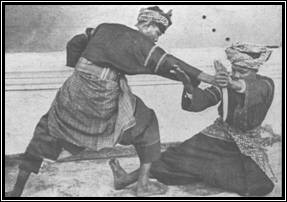
silek of Minangkabau people photographed by colonial administrator of the Netherlands in the beginning of 20th century (Collection of the State Museum Adityawarman, West Sumatra, Indonesia).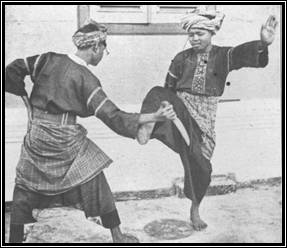
silek of Minangkabau people photographed by colonial administrator of the Netherlands in the beginning of 20th century (Collection of the State Museum Adityawarman, West Sumatra, Indonesia).
surau A was built originally in 1918, afterward underwent renovations several times.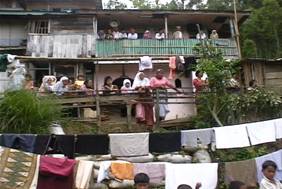
People who gather in surau on a daily basis belong to same matrilineal clan.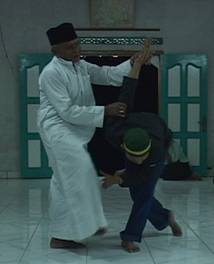
The imam instructs pupil techniques of silek. In surau A daily practice of silek is mainly carried out at a worship room after evening worship (Maghreb).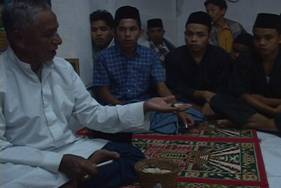
After training, the imam gives a lecture to his pupil. Here, he takes a rock in hand, and explains about a role of a rock in the practice of Islamic mysticism. When the pupils leave the surau to go work away from home, before they depart, the imam always gives them a rock as a means of praying for their safety.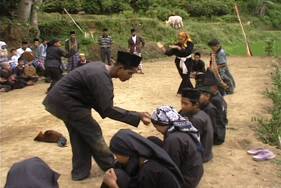
The day before Ramadan and the end of training, a chicken is slaughtered, and as its fresh blood is being sprinkled on the soil for a new training ground, the master's assistant mark students' foreheads and feet with the blood. This acts as a form of protection from unseen threats such as magic and spirits.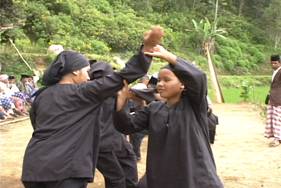
On day-off or holidays, training followed by ritual, takes place in the training hall in front of surau in the afternoon when many villagers can gather.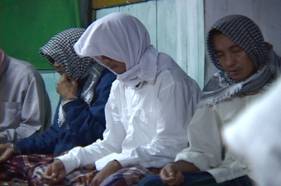
At the surau, when Ramadan comes, villagers, young and old, practice dzikir led by the imam, day and night, by themselves, or in groups. Many young practitioners of silek also participate.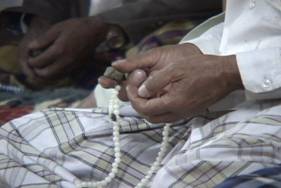
Practicing dzikir involves the use of a small rock. The rock will appear along with the person at their final judgment, with the rock said to keep one from forgetting their faith. By feeling the rock held in one's fingertips while reciting scripture repeatedly, it is said that one can find deeper unity of mind and body with their faith in God.
Notes
[1] This paper re-analyses techniques of the body from the perspective of sensory anthropology. It is based on data obtained from fieldwork on the techniques of the body and religious practices of the Minangkabau people, conducted in the inland region of West Sumatra, Indonesia. This fieldwork consisted of preparatory surveys conducted from 2000 to 2002, as well as the main surveys, conducted from 2002 to 2004. In particular, it aims to consider views on the body, looking at how techniques, customary laws of the Minangkabau society and religion are integrated within the minds and bodies of practitioners.
[2] I employed visual anthropological methodologies in the main surveys carried out from 2002 to 2004. More specifically, I filmed techniques being employed within continuous time and space. Following this, by looking and listening at these videos with people in the survey area and discussing their content, I incorporated their perspectives into my investigations and discussed these from various perspectives. Furthermore, by paying attention to what was being filmed in a way that transcended the intentions of people in the survey area and of the cameraman, we were able to have discussion on kinds of issues that usually go unrecognized. This paper takes the perspectives obtained through these surveys as the foundations for considering techniques of the body. The photographs employed in this study are based on the videos taken during surveys.
[3] Until now, the customary laws of matrilineal Minangkabau society and the coexistence of Islam have been the subject of focus from the perspectives of cultural anthropology and Islamic studies. However, this research makes it easier to examine the issues in more depth by making the techniques of self-defense based on techniques of the body the subject of investigation.
References
- A.A. Navis
1986 Alam Terkembang Jadi Guru: Adat dan Kebudayaan Minangkabau. PT Pustaka Grafitipers, Jakarta.
1996 Peribahasa Minangkabau. Penerbit Intermasa, Jakarta. - Ahmad Dt. Batuah, A. Dt. Madjoindo
1956 Tambo Minangkabau. Balai Pustaka, Jakarta. - (Prof. Dr.) Azyumardi Azra
2003 Surau: Pendidikan Islam Tradisional dalam Transisi dan Modernisasi. PT Logos Wacana Ilmu, Jakarta. - Badan Pusat Statistik Kabupaten Tana Datar, Badan Perencana Pembangnan Daerah (BAPPEDA) Kabupaten Tanah Datar
2002 Tanah Datar dalam Angka 2001. - Badan Pusat Statistik Propinsi Sumatera Barat, Badan Perencanaan Pembangnan Daerah (BAPPEDA) Propinsi Sumatera Barat
2002 Sumatera Barat dalam Angka 2001. - Draeger, Donn F.
2000 The Weapons and Fighting Art in Indonesia. Tuttle Publishing, Singapore. - Hamka
1985 Islam dan Adat Minangkabau. Pustaka Panjimas, Jakarta - Kato, Tsuyoshi
1982 Matriliny and Migration: Evolving Minangkabau Traditions in Indonesia. Cornell University Press. - H.Abdul Kadir Usman, Dt.Yang Dipatuan
2002 Kamus Umum Bahasa Minangkabau Indonesia. Anggrek Media, Padang. - H. Mahmud Junus
1971 Sedjarah Islam di Minangkabau. Al-Hidajah, Jakarta. - Icon Group International, Phillip M. Parker (ed)
2010 Minangkabau: Webster's Timeline History, 1819 - 2007. Icon Group International, Inc. - (Drs.) Mid Jamar
1985 Filsafat dan Silsilah Aliran-Aliran Silat Minangkabau. (Research Paper) Akademi Seni Karawitan Indonesia, Padangpanjang. - Muhamad Radjab
1958 Tjatatan di Sumatera. Dinas Penerbitan Balai Pustaka, 1958. - Pauka, Kirstin
1998 Theater and Martial Arts in West Sumatra: Randai And Silek of The Minangkabau. Ohio University Center for International Studies. - Proyek Penelitian dan Pencatatan Kebudayaan Daerah (Azinar Sayuti, Rusli, Anwar, Jusrizalsaadoeddin)
1978 Perkembangan Seni Bela Diri Traditional di Sumatera Barat. Departemen Pendidikkan dan Kebudayaan, Jakarta. - Soetan Pamoentjak
1935 Kamoes Bahasa Mianangkabau - Bahasa Melajoe-Riau. Balai Pustaka, Batavia. - Umar Yunus
1980 Kebudayaan Minangkabau in Manusia dan Kebudayaan di Indonesia, Koentjaraningrat(ed), Djambatan, 1971. - Zenwen Pador
2002 Kembaki ke Nagari: Batuka Baruak Jo Cigak? Lembaga Bantuan Hukum. Padang.











